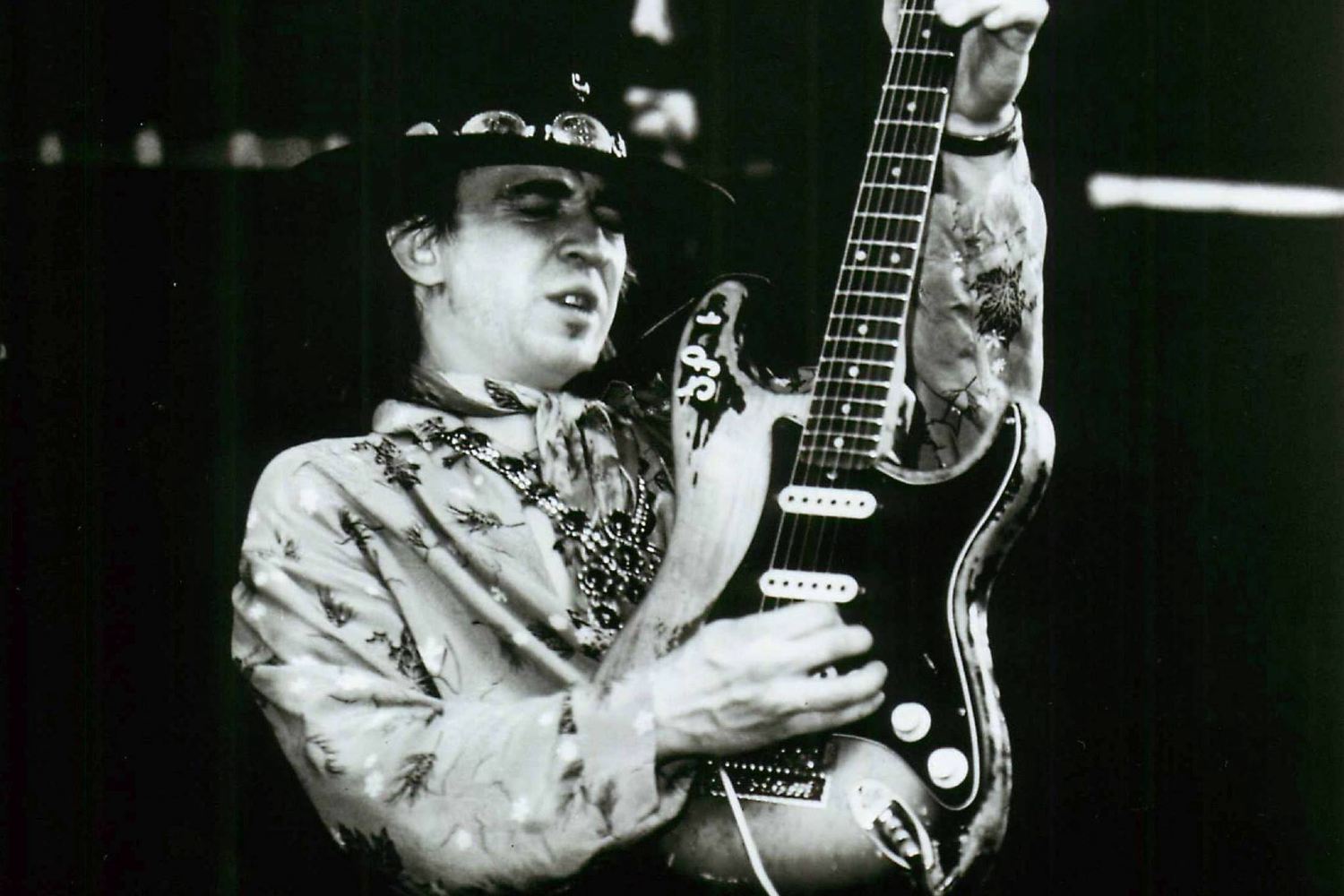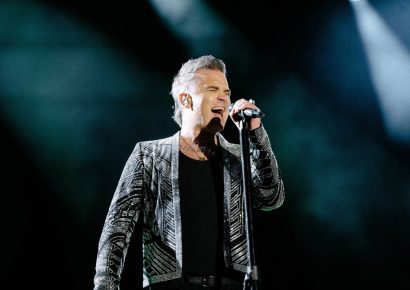Stevie Ray Vaughan was nothing short of legendary.
After an extended period cutting his teeth on Austin’s live scene throughout the ’70s, Stevie Ray Vaughan received his first big break at the 1982 Montreux Jazz Festival, delivering a show-stopping performance and capturing the attention of an enchanted audience.
Among the audience was a gobsmacked David Bowie, who would later invite the young Texan to lay down guitar on a number of tracks on his upcoming album Let’s Dance, including a memorable guitar solo on the irresistably funky title track that netted him his first #1 single.
Read up on all the latest interviews, features and columns here.
From there, Vaughan was catapulted into the mainstream, landing a recording contract and having fans and players alike hail him as the saviour of the blues. It’s probably fair to say that Vaughan’s influence as a guitar player is only rivalled by that of Jimi Hendrix, and his onstage antics and eccentric dress sense only drew further comparisons between the two, giving emerging players an authentic and exciting new guitar hero to look up to in a decade dominated by cheesy hair metal and sequenced, rigid drum machines.
To commemorate 30 years since his tragic death, we’re cherishing the memory of Stevie Ray Vaughan by diving into ten of his greatest guitar tracks, paying close attention to his uncanny technique and celebrating him as one of the all-time-greats of guitar history.
‘Pride and Joy’ – Texas Flood (1983)
What better way to kick off Stevie Ray Day than with the smokey Texan blues of ‘Pride and Joy’? Atop of a wonderful boogie groove, Vaughan’s elastic right wrist comps out some classic bluesy shapes before kicking things up a notch, slamming on his overdrive and breaking out a total scorcher of a guitar solo to see out the track.
To this day, Stevie’s guitar tone on this track is unbeatable, and there’s very few blues tracks that have ever matched the unmistakable swagger of this number.
‘Texas Flood’ – Texas Flood (1983)
The mark of any true bluesman comes down to how they can handle soloing over a classic Southern slow burner, and there’s no disputing that it was here where Stevie felt most at home. The lumbering title track of his debut LP sees the wunderkind wrangle his way through a searing passage of slippery licks, delivering some obscene two-step bends and wild tremolo action to drive the message home to his audience.
Ever the showman, Stevie would often perform chunks of this solo with the guitar behind his back, barely missing a beat as he’d shred away to his heart’s content.
‘Lenny’ – Texas Flood (1983)
While it was Stevie Ray Vaughan’s stage tricks and lickety-split shredding that wowed crowds the most, the Texan also possessed a tender side that saw him pen more than a few swooning major-key guitar instrumentals over his time. One of his earliest and most beloved of these came with the liquid changes of ‘Lenny’, named for his then-wife Lenora, who also gifted Vaughan his famous ’63 Stratocaster of the same name.
Here, Stevie utilises a moveable Major 6th chord as the foundation for his blissfully melodic lead playing, adding dollops of vibrato and jazzy runs to make for one of his most enchanting showcases to date.
‘Scuttle Buttin’’ – Couldn’t Stand The Weather (1984)
When it came time to follow up on the success of Texas Flood, Stevie made sure to kick things off with a bang, and boy oh boy did he deliver ‘Scuttle Buttin’’. Clocking in under the two minute mark and traveling at a sweat-inducing tempo of 160bpm, this lightning fast instrumental is best-known for demonstrating Vaughan’s ludicrously zippy fretwork, with the Texan tearing his way up and down the fretboard in a manner that’s never been matched since.
The main riff that carries the tune is commonly regarded among bluesologists as one of the toughest SRV licks to learn, and I can confirm on a first-hand basis that trying to finesse this riff at the correct tempo is probably the most maddening exercise a young guitarist can do – but it’s so worth it.
‘Couldn’t Stand The Weather’ – Couldn’t Stand The Weather (1984)
You know those kinds of songs that make you want to don a pair of dark glasses and smoke a cigarette like some trendy, troubled private investigator in an ‘80s cop flick? This is one of them. From the tease of its stop-start intro to Stevie’s funky verse playing and that irresistible driving breakbeat, ‘Couldn’t Stand The Weather’ just oozes cool out of every possible orifice.
It’s here in particular that I’d also like to draw attention to the sheer force of Vaughan’s Double Trouble bandmates, bassist Tommy Shannon and drummer Chris Layton, who are just as important to the story of Stevie Ray, and their talent truly shines in the rhythm section on this number.
‘Look At Little Sister’ – Soul To Soul (1985)
In the eyes of most fans, Soul To Soul marks one of Stevie Ray Vaughan’s weaker studio efforts, which many put down to Stevie’s patchy songwriting and his concerning addictions to cocaine and alcohol around this era. Nonetheless, Soul To Soul packs its fair share of hit moments: Stevie using two wah pedals simultaneously on ‘Say What!’ makes for a memorable track and ‘Come On, Pt. III’ is yet another excellent Hendrix tribute, and of course, there’s ‘Look At Little Sister’.
It’s an amazing tune, and it gets even better when you see him play it in Austin in 1989, where he breaks a string mid-solo and manages to coordinate a guitar change with his tech – all without missing a beat.
‘Voodoo Child (Slight Return)’ – Live Alive (1987)
It goes without saying that Stevie Ray Vaughan was, like most young blues players are, totally enamoured with Jimi Hendrix. From the way he played his guitar (E-Flat, often behind his back) through to the way he dressed, it wasn’t difficult to see that Stevie channeled Hendrix in almost every aspect of his musical career – he even owned Hendrix’s old Vox 846 wah pedal at one stage – and honoured the influence of his hero through a number of covers.
Perhaps one of the most noted, Vaughan’s rendition of ‘Voodoo Chile (Slight Return)’ from Hendrix’s Electric Ladyland album became a staple of his live show, letting him run rampant across the fretboard as if it was going out of style. While his cover originally appeared on Couldn’t Stand The Weather, one only needs to go as far as 1987’s Live Alive (an album often derided by many critics due to the awful mix and Stevie’s sloppy playing) to cop a taste of how Vaughan channeled the spirit of Hendrix for a new generation.
‘Tightrope’ – In Step (1989)
After booking in for a stint in rehab to knock his issues with substance on the head and then enduring a nasty divorce from his wife, Stevie Ray Vaughan returned to the studio with Double Trouble at the tail end of the ‘80s to record his next album. With a fresh look on life and a notebook full of new songs about addiction, infidelity and redemption, Stevie turned the turmoil of his previous years into In Step, a watertight full-length effort that reaffirmed his status at the top of the guitar world.
On ‘Tightrope’, Vaughan uses a funky blues number to address his problems with substance abuse and admit that he nearly let his habits take his career off course, demonstrating his newfound knack for honest songwriting and – as expected – dialling in a pretty tough guitar solo to remind everyone who the boss was.
‘Riviera Paradise’ – In Step (1989)
Maybe one of the most tantalising moments in Stevie Ray Vaughan’s discography, ‘Riviera Paradise’ functions as another slow-burning instrumental track, but this one’s slightly different from the rest of Stevie’s instrumentals. ‘Riviera Paradise’ offers a glimpse of the new direction Vaughan was beginning to explore as a guitar player, decorating his tried-and-true style with a number of phrases and chordal embellishments that drew from jazz and contemporary soul.
This one also functions as another exemplary showcase for Double Trouble, particularly the addition of keys player Reese Wynans, with him and Stevie trading licks and augmented phrasings over the span of the track to see out In Step and make for a supremely underrated addition to the SRV canon.
‘Little Wing’ – The Sky Is Crying (1991)
One of the finest moments from the posthumously released compilation The Sky Is Crying, this one sees Stevie Ray Vaughan take one of Jimi Hendrix’s most iconic tracks and rework it to make for one of the most memorable guitar instrumentals ever. Vaughan’s version of ‘Little Wing’ netted him a 1993 Grammy Award for Best Rock Instrumental Performance, and is considered by many guitarists to the only version that could hold a flame to Jimi’s original – possibly the highest honour any guitarist could obtain.
If you’re looking for the ultimate Stevie Ray Vaughan masterclass, this is it: there’s not a single sour note to be heard anywhere, and Vaughan’s phrasing is just simply impeccable from start to finish. Suffice to say, there’ll never be another player quite like Stevie.
This article was originally published August 27, 2020.
Never miss a story – sign up to our mailing list for all the latest news, reviews, features and giveaways.







